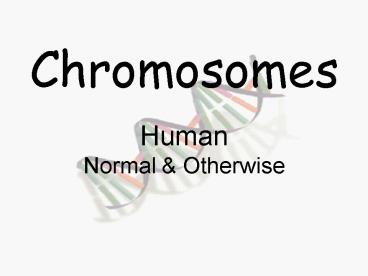Chromosomes - PowerPoint PPT Presentation
1 / 21
Title:
Chromosomes
Description:
This is an example of trisomy 21 (47, XY, 21) also known as Down syndrome. ... Of those born with Down syndrome, 1/6 die within the first year and the average ... – PowerPoint PPT presentation
Number of Views:97
Avg rating:3.0/5.0
Title: Chromosomes
1
Chromosomes
Human Normal Otherwise
2
Human Female Karyotype
3
How a Karyotype is made
Cells must first be grown in culture, then
stimulated to divide. As the cells enter
metaphase, a chemical agent that produces a
banding pattern is applied, and then a picture is
taken of the chromosomes. A technician then
arranges the chromosomes in groups as shown on
the next slide.
4
Human Female Karyotypewith chromosomes paired
5
Human Male Karyotype
6
Human Male Karyotype with chromosomes paired
7
Jacobs Syndrome - Male XYY
Jacobs Syndrome is a chromosome aberration which
is caused by nondisjunction of the Y chromosome
during the second phase of meiosis giving a 47
XYY karyotype. Occurence is 1/1000 live male
births. Men with this karyotype are tall and have
low mental ability.
8
Jacobs Syndrome - Male XYY
9
Jacobs Syndrome - Male XYY
10
Klinefelters Syndrome
This karyotype shows a variant of Klinefelter's
syndrome. Individuals with this syndrome are
male, typically with the karyotype 47,XXY. They
exhibit a characteristic phenotype including tall
stature, infertility, gynecomastia and
hypogonadism. Aneuploidy above one extra
chromosome is usually fatal but because of
X-inactivation, which "turns off" all but one X
chromosome per cell, the effects of 3 extra
chromosomes are reduced.
11
Klinefelters Syndrome
12
Klinefelters Syndrome
13
Philadelphia Syndrome
Here is the so-called "Philadelphia chromosome"
of chronic myelogenous leukemia, which is really
a 922 translocation. A section of the 9
chromosome has been translocated to 22. Chronic
myelogenous leukemia is a malignant cancer of the
bone marrow that causes rapid growth of the blood
forming cells (known as myeloid precursors) in
the bone marrow, peripheral blood, and body
tissues.
14
Philadelphia Syndrome
15
Inversion on Chromosome 16
This image shows an inversion of chromosome
16. By looking carefully at the pair of 16, you
will see that the chromosome on the left looks
different from the one on the right. The left one
is normal and the right one is inverted near the
centromere. Inversions, by definition, do not
involve loss or gain of chromosomal material. If
the breakpoints of the inversion do not disrupt
genes they may not have an associated phenotype.
16
Inversion on Chromosome 16
Centromere
17
DiGeorge Syndrome
Individuals with the DiGeorge syndrome often have
cardiac defects, immune system deficiencies and
can be moderately retarded. The cause of the
DiGeorge syndrome is a defect in chromosome 22,
where one of the bands in the long arm has been
deleted.
18
DiGeorge Syndrome
19
DiGeorge Syndrome
20
Trisomy 21
This is an example of trisomy 21 (47, XY, 21)
also known as Down syndrome. Note the extra
chromosome 21. Additions or deletions of genetic
material are generally lethal in utero. Trisomy
21 is an example of one form of addition in which
the fetus may occasionally survive to term and
beyond. Of those born with Down syndrome, 1/6 die
within the first year and the average life span
is 16.2 years. The non-dysjunctional event in
meiosis that produces this anomaly increases in
incidence with increasing maternal age. The
average risk of having a child with trisomy 21 is
1/750 live births. Mothers in their early
twenties have a risk of 1/1,500 and women over 35
have a risk factor of 1/70, which jumps to 1/25
for women 45 and over. Trisomy 21 is one of the
most common causes of mental retardation. The
child can have an IQ between 25-74. An average
person has an IQ between 90-110. This results in
a number of characteristic features, such as
short stature, broad hands, stubby fingers and
toes, a wide rounded face, a large protruding
tongue that makes speech difficult. Individuals
with this syndrome have a high incidence of
respiratory infections, heart defects, and
leukemia.
21
Trisomy 21































